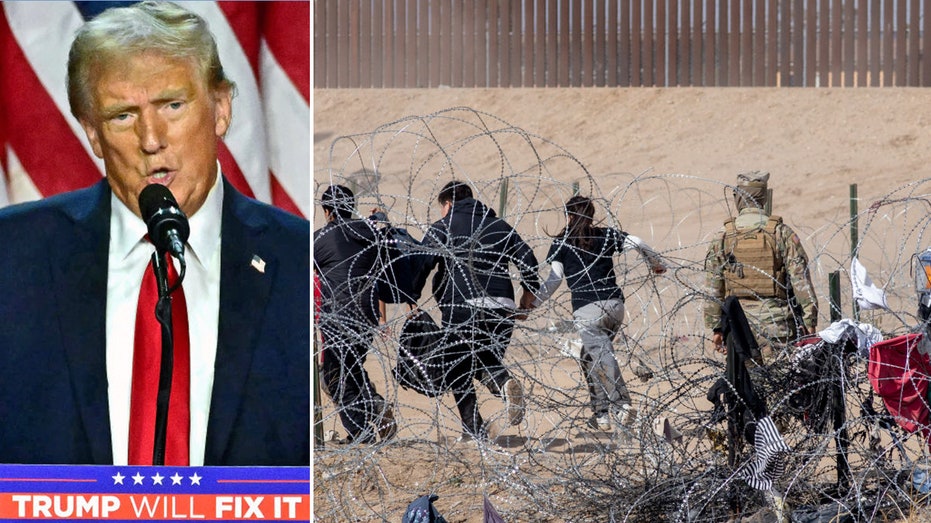
Immigration and border security will likely be front and center of the incoming Trump administration’s agenda when it takes office in 2025.
Immigration and border security were hot topics in 2024 as the Biden administration continued to tackle the historic migrant crisis at the southern border, migrant crime made headlines across the country, and both topics were top priorities for voters ahead of the November election.
In 2025, those topics are likely to remain key issues. Here are five things to watch in 2025:
BORDER STATE OFFERS TRUMP MASSIVE PLOT OF LAND TO AID MASS DEPORTATION OPERATION
President-elect Trump has promised to launch a historic mass deportation program next year. He has expressed openness to declaring a national emergency and using military assets in order to get it done. His team have already started looking at how to expand detention near major metropolitan areas.
Trump’s border czar, Thomas Homan, has promised that national security and public security threats will be the priority, but no illegal immigrant is off the table. The Trump administration increased deportations significantly up until 2019 before COVID-19 hit the U.S., so it is expected to move in that direction again.
Trump may need to rally Congress for additional resources, a task made easier by Republican control of the House and Senate, and will need to overcome potential lawsuits filed against any policies he introduces.
At the congressional level, expect a push for a sweeping bill like H.R.2, the Republican border bill passed in 2023 that would limit asylum significantly while providing additional resources at the border.
Officials in multiple Democratic states have already previewed their resistance to the deportation push by the Trump administration. Denver Mayor Mike Johnston said recently he was prepared to go to jail over his opposition to Trump’s deportation plan.
Meanwhile, governors in Massachusetts, Illinois and Arizona have all said that they won’t cooperate with deportations.
Trump officials say they don’t need their assistance, only for them to step aside as federal authorities do their job. But it will be something to watch to see whether Democratic officials merely do not assist the administration, or whether that turns to active resistance.
Mexico plays a crucial role in securing the U.S.-Mexico border, with lower levels of encounters at the U.S. border often coinciding with crackdowns at Mexico’s southern border.
That was on display in 2024, as numbers lowered at the border after Biden administration officials met with Mexican officials in December 2023. The two countries had previously come to an agreement by which the U.S. would allow in migrants via parole programs, while Mexico would consequently accept a certain number of non-Mexican returns back from the U.S.
But with President-elect Trump having promised to end those programs, the extent to which Mexico will continue to cooperate remains unclear.
Trump has promised to impose a significant 25% tariff on goods from Mexico if it does not halt the flow of illegal immigrants across the border. It’s a similar tactic by which Trump got Mexico to agree to the 2019 expansion of the remain-in-Mexico policy.
But will it work? Will Mexico keep the traffic heading north low, or will it reduce its enforcement? That will be a question answered in 2025.
CLICK HERE FOR MORE COVERAGE OF THE BORDER SECURITY CRISIS
Congress has struggled to find consensus on border security and immigration, something that has frustrated multiple administrations. President Biden and former President Barack Obama were thwarted in their efforts to get Congress to pass comprehensive immigration reform, while President-elect Trump struggled to get lawmakers to provide funding for the wall at the southern border.
Now, Republicans hold the House and Senate, but by thin margins. So it is unclear if Trump will ever see a sweeping bill similar to the House Republicans’ border bill that passed the chamber in 2023 come to his desk.
Trump can do a great deal by executive action, but his mass deportation plan will require additional funding from Congress. The extent to which Congress acts on those requests could determine how successful that effort, along with additional security at the southern border to stop migrants from entering the U.S. in the first place, will be.
While illegal immigration is in the spotlight after the historic crisis at the southern border, it will likely be a key issue in the next administration, with some keen for additional restrictions on not only the use of humanitarian parole but also visas like the H-1B visa tech worker program and the H-2A agricultural worker program.
Additionally, the administration may attempt to re-implement its 2019 public charge rule, which limited legal immigrants from receiving green cards if they have used some forms of welfare and are deemed to be likely to be reliant on welfare in the future. The administration is expected to reduce the numbers coming in via parole, which was expanded significantly under the Biden administration, and is also expected to reduce the annual refugee cap.
President-elect Trump and others in his future administration – including billionaire Elon Musk – have said at times they want more immigration, but only legal immigration.
“I want a lot of people to come into our country, but I want them to come in legally,” Trump said in October.
But some in Trump’s base want lower levels of immigration overall, including legal immigration. Which side of the argument wins will become clearer as 2025 rolls on.


